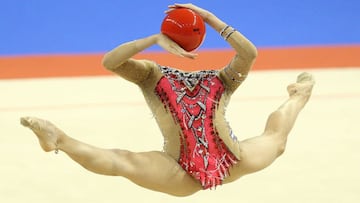What are the four apparatus in Rhythmic gymnastics?
In rhythmic gymnastics, there are five routines, but the sport’s government body (FIG) decided only four of them will be seen at Tokyo Olympics.

In individual competitions twenty-six gymnasts will compete in ball, hoop, ribbon and clubs. Only the best ten will qualify to the golden final. Conversely, in team competition, fourteen groups of five gymnasts will each compete in two apparatus: five balls and three hoops/two clubs. Only eight teams of those fourteen will qualify for the medal round.
Tokyo 2021 rhythmic apparatus
Ball
The ball can only be made of plastic or rubber , with a diameter of 18-20 cm it must weigh less than 14.1 ounces.
The ball routine rules include the ball resting in the gymnast’s hand and not in the wrist, as well as continued flowing movements and the mandatory use of both hands in the exercise. Other compuulsory requirements include bouncing, throwing and rolling.
Hoop
The hoop can only be made out of plastic or wood, with a diameter of 80-90 cm it must weigh less than 10.6 ounces.
Compulsory elements for a hoop routine include hand and body rotations, rolling, swings, circles, throws, and passes through and over the hoop.
Clubs
The clubs must be made from wood or synthetic material. With both clubs having to be the same length (16-20 inches), they can only with a maximum 5.3 ounces each.
Clubs have to be passed from hand to hand and each pass must go underneath the other clubs been caught with the opposite hand to the one was used to throw. Double and triple spins are expected in order to the club to be simplify more complex routines, such as 360s to be performed underneath.
Ribbon
Related stories
The ribbon apparatus’ stick must be made of wood or synthetic material with a ribbon tied to the end made of satin or a likewise non-starched material. With a stick’s maximum diameter of .39 inches and a length between 19.5 and 23.4 inches, the ribbon should be at least 19 feet, 8 inches. It’s maximum weight is roughly one ounce.
Fundamental requirements include flicks, circles, snakes, spirals, and throws. Good co-ordination and concentration is needed to form spirals and circles as any knot or difficulty with the ribbon is highly penalized. Large, smooth and flowing movements are valued, while if at some point the ribbon stops moving a penalization will take place.


